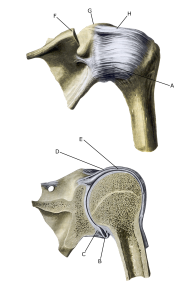Anatomy
 The shoulder joint consists of the humeral head of the humerus (caput humeri) and the articular surface of the scapula (cavitas glenoidalis). A meniscus (labrum glenoidale) runs all the way around the edge of the shoulder blade’s articular surface.The joint is surrounded by a joint capsule that is reinforced by several ligaments. Surrounding the joint capsule are the shoulder muscles that further reinforce the joint.
The shoulder joint consists of the humeral head of the humerus (caput humeri) and the articular surface of the scapula (cavitas glenoidalis). A meniscus (labrum glenoidale) runs all the way around the edge of the shoulder blade’s articular surface.The joint is surrounded by a joint capsule that is reinforced by several ligaments. Surrounding the joint capsule are the shoulder muscles that further reinforce the joint.
Shoulder joint:
A. Capsula articularis
B. Capsula articularis
C. Labrum glenoidale
D. Capsula articularis
E. biceps brachii (caput longum)
F. Acromion
G. Processus coracoideus
H. Ligamentum coracohumerale
Cause
In the event of a violent load, the joint head of the upper arm can be pressed or torn completely (dislocation) or partially (subluxation) out of the articular surface of the shoulder blade. Subluxations occur most frequently if the shoulder has previously been completely dislocated. Dislocations always result in rupture or tearing of the joint capsule. In 90% of dislocations, the ligaments (glenohumeral ligaments) and muscles are torn, the meniscus is damage e (labrum glenoidale), and in some cases, cartilage and bone are also torn from the joint surfaces (Bankart and Hill-Sach lesions). As a result, the shoulder often becomes unstable.
(Sub)dislocations occur most frequently after a single severe trauma, but can be caused by congenital looseness (multidirectional instability), for example in hypermobile people or due to instability after sports activities above head height (throwing, racket sports, swimming). However, the latter rarely causes dislocations.
Symptoms
A total joint dislocation (dislocation) immediately causes severe pain in the shoulder after a heavy load or fall. Mobility in the arm is severely reduced due to pain. You will often (but not always) be able to see that the shoulder is dislocated.
In some cases, the joint head slips back into place on its own, often almost immediately, after which the pain is greatly reduced and the arm can be used again. In other cases, there is only a partial dislocation (subluxation), where the joint head is only partially and briefly dislocated.
Ruptures of the joint capsule and ligaments can lead to chronic looseness in the shoulder, causing the shoulder to repeatedly partially dislocate (subluxation), which is felt as a sudden pain and loss of strength (‘Dead Arm’), especially when the arm is held above and behind the head (abducted and externally rotated).
Examination
All cases of suspected total or partial shoulder dislocation require a medical examination, always checking for nerve and vascular involvement (pulse in the radial artery, function of the three major nerves in the hand (radial, median and ulnar nerves) and sensation of the shoulder rounding (axillary nerve). Clinically, there is often normal or near normal range of motion with good power.
There is a positive apprehension test and positive relocation test. Special X-ray examination should be performed in 2 planes showing bone tears in 10%. In some cases, there will be an indication for CT, MRI or ultrasound scanning.
Treatment
The dislocated shoulder should be repositioned once the diagnosis is confirmed by X-ray, and the X-ray of the shoulder in 2 planes should be repeated once the shoulder is repositioned. After a calm regime for a few days, the arm can then be used according to ability. There is no indication for an arm sling. Most cases of partial dislocation and looseness of the shoulder joint can be rehabilitated. The rehabilitation aims to strengthen the muscles around the shoulder joint.
If, despite rehabilitation, (partial) dislocation of the shoulder joint continues to occur, the indication for surgery should be reassessed. Athletes under the age of 20 have a 60-100% risk of re-dislocation and are usually offered stabilisation surgery.
The risk decreases with age. Surgery is therefore often offered to active people under the age of 30 already at the first shoulder dislocation, as is often the case for dislocations combined with joint slippage combined with other injuries such as meniscus or cartilage/bone damage. The risk of dislocation recurrence after stabilising surgery is approximately 15% within the first 10 years. The alternative to surgery is reduction of activity level (Nazzal EM, et al. 2023, Lei D, et al. 2023, Alkhatib N, et al. 2023).
Complications
After (partial) dislocation of the shoulder, there is often looseness of the shoulder joint, which increases the risk of secondary injuries.
In particular, the following should be considered:
